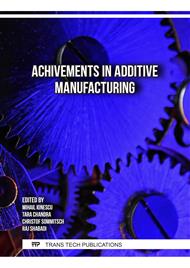p.1
p.7
p.13
p.19
p.27
p.33
p.41
p.47
Effect of Isothermal Annealing on Residual Stresses and Fatigue Properties of LPBF 316L Steel
Abstract:
This study aims to investigate the influence of isothermal annealing on the residual stresses and fatigue properties of a 316L austenitic stainless steel, manufactured by the laser powder-bed fusion (LPBF), possessing a high density of 99.98%. Residual stresses were evaluated using the X-ray diffraction techniques. High-cycle fatigue tests were performed on cylindrical samples manufactured in both horizontal and vertical orientations, subjected to force-controlled axial fully reversed loading. Following fabrication, the samples underwent isothermal annealing in a furnace either at 600 °C for 120 minutes or at 900 °C for 30 minutes. Subsequently, the samples were machined to their final dimensions and electropolished to a mirror surface finish. Preliminary findings revealed that increasing the annealing temperature effectively reduced the surface residual stresses. However, this reduction did not lead to an improvement in the fatigue resistance of this nearly fully dense material in the high-cycle fatigue regime. Interestingly, the structure annealed at 600 °C exhibited a higher fatigue strength compared to the structure annealed at 900 °C, with no discernible difference between the printing directions. Fracture surfaces and microstructural features examined using light and electron microscopy revealed that cracking was primarily initiated at surface defects or slip bands. These results highlight the complex interplay between residual stresses, microstructure, strength, and fatigue behaviour of LPBF 316L austenitic stainless steel. Further analysis and investigations are required to fully understand the underlying mechanisms and develop strategies for enhancing the fatigue performance of additive manufactured components.
Info:
Periodical:
Pages:
13-18
Citation:
Online since:
November 2023
Keywords:
Price:
Сopyright:
© 2023 Trans Tech Publications Ltd. All Rights Reserved
Share:
Citation:



